Art Gallery of Western Australia
The Art Gallery of Western Australia (AGWA) is a public State art gallery that is part of the Perth Cultural Centre, in Perth. It is located near the Western Australian Museum and State Library of Western Australia and is supported and managed by the Department of Local Government, Sport and Cultural Industries of the Government of Western Australia. The current gallery main building opened in 1979. It is linked to the old court house – The Centenary Galleries — which house the historical collection.
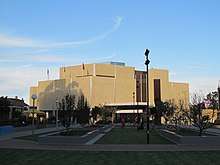 | |
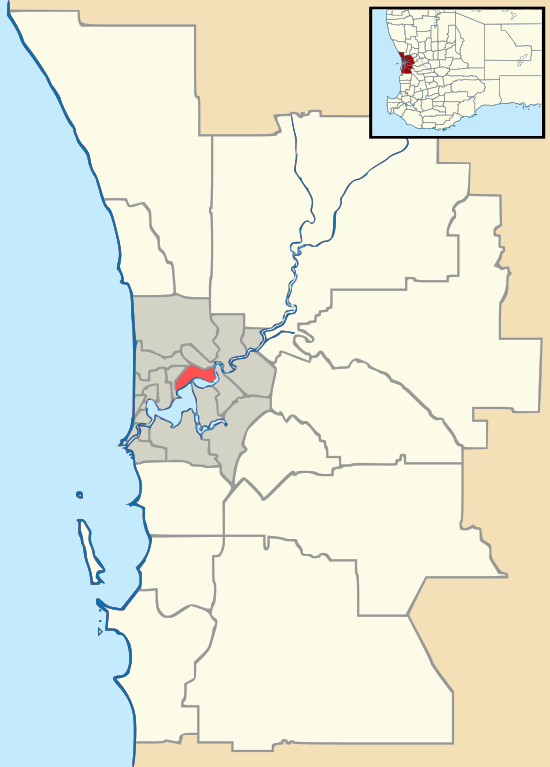 Location within Perth | |
| Established | 1895 |
|---|---|
| Location | Perth Cultural Centre, Perth, Western Australia |
| Coordinates | 31.9507°S 115.8610°E |
| Type | Art gallery |
| Collection size | 17,000 |
| Visitors | 400,000 |
| Director | Stefano Carboni |
| Owner | Government of Western Australia |
| Public transit access | Perth railway station, Transperth |
| Website | www |
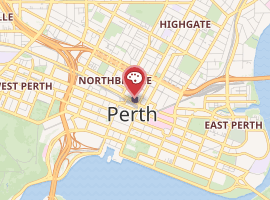
| |
| Designated | 28 August 2001 |
| Reference no. | 1962 |
History
The Art Gallery was originally housed in the Jubilee Building with the State Museum and Library.[1] The Jubilee Building, which was intended to be a public library only, was to be opened in honour of Queen Victoria's Golden Jubilee in 1887, but instead, only the first stone for the foundation was laid.[1] The foundation stone was laid for the Art Gallery in July 1901 by the Duke of Cornwall and York, shortly after the federation of Australia.[1]
Several notable individuals were involved with the development of the Jubilee Building and Art Gallery, including John Winthrop Hackett, James Battye, Ludwig Glauert, George Pitt Morison[2] and George Temple-Poole.[1] Sir James Dromgole Linton recommended purchases for the State Art Collection.[3]
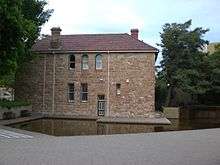
The Art Gallery Administration Building is housed in the former Police Quarters, designed by architect Hillson Beasley, who also designed Government House.[4] It was built during the economic boom created by the 1890s Kalgoorlie gold rush.[4] The Administration Building moved into the Police Quarters in the 1970s during the nickel mining boom.[4]
The Main Gallery Building was built in 1977, and was also spurred by the mining boom.[5] Western Australia was also placing more importance on cultural institutions, and the government was inspired by the upcoming 150th anniversary of federation in 1979.[5] Construction of the Alexander Library began in the same period.[5]
The architect of the main gallery building was Charles Sierakowski from the Public Works Department, who worked with engineer Philip Nadebaum and architectural company, Summerhayes and Associates.[5] It was designed in the Bauhaus method with a Brutalist exterior, which was popular in European design.[5] The slab and shear head column system was an innovative architectural feature in Western Australia at the time.[5]
In 2017 AGWA announced plans to redevelop its sizable rooftop as focus for sculpture, events, restaurants, film etc in a project called AGWA Elevate” targeted for opening before the Gallery’s anniversary in 2020. The Government of Western Australia has pledged $10m towards this project. ‘Six Seasons” a high profile project to increase the focus on AGWA’s Indigenous collection was launched in 2017, and a new dedicated permanent Indigenous gallery was inaugurated alongside “Plain Speak” a special exhibit for the Perth International Arts Festival.[6]
Gallery of selected works
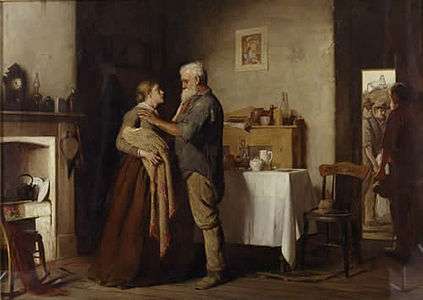 John Longstaff, Breaking the News, 1887
John Longstaff, Breaking the News, 1887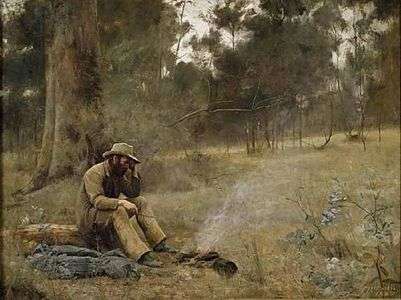
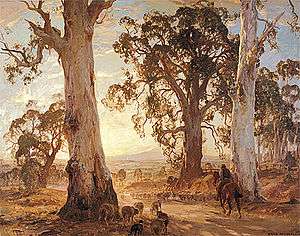 Hans Heysen, Droving into the Light, 1921
Hans Heysen, Droving into the Light, 1921
Exhibitions
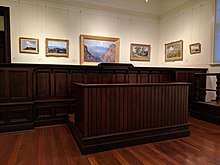
The Aesthetic Movement inspired aspects of the Art Gallery's collection.[7]
Ongoing exhibitions include Indigenous traditional and contemporary art from the Northern Territory and Western Australia, and Western Australian art from the 1820s to 1960s[8] alongside topical displays on key themes drawn from the collection. Desert River Sea is a major project exploring indigenous art. Desert River Sea: Kimberley Art Then and Now is a ground-breaking six-year visual arts initiative developed by the Art Gallery of Western Australia with funding support from the Rio Tinto Community Investment Fund. Its aim is to bridge the cultural and geographic distance between Aboriginal artists of the diverse Kimberley region, the Gallery in Perth and national and international audiences, thereby forging a network of cultural and artistic exchange and understanding. An annual exhibition called "Year 12 Perspectives" celebrated 25 years in 2017 and highlights works from Western Australian Art and Art and Design students, including paintings, prints, digital art, fashion, design, and sculpture.[8]

References
- "Register of Heritage Places: Art Gallery & Museum Buildings" (PDF). 28 August 2001. Archived from the original (PDF) on 11 April 2008. Retrieved 3 January 2008.
- Morison, George Pitt (1929). Illustrated Catalogue of the Art Gallery. Perth: Public Library, Museum and Art Gallery of Western Australia. Retrieved 3 May 2020.
- "The Linton Legacy". The Art Gallery of Western Australia. 2005. Archived from the original on 3 April 2018. Retrieved 14 May 2020.
- "Register of Heritage Places: Art Gallery Administration Building" (PDF). 24 March 2000. Archived from the original (PDF) on 11 April 2008. Retrieved 3 January 2008.
- "Register of Heritage Places: Art Gallery of Western Australia Complex" (PDF). 9 May 2006. Archived from the original (PDF) on 11 April 2008. Retrieved 3 January 2008.
- "Everyone has a history – Part One: Plain Speak". Art Almanac. 17 February 2017. Retrieved 13 May 2020.
- "Art Gallery of Western Australia". Museums of the World. Retrieved 14 May 2020.
- "Year 12 Perspectives: WA Art Gallery". Museum of Freedom and Tolerance Western Australia. Retrieved 13 May 2020.